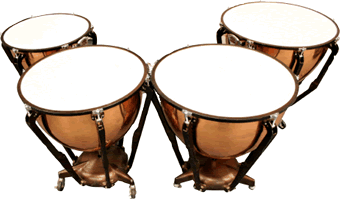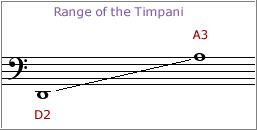 General Information General Information
Even when an orchestral piece doesn't require much percussion
sound, you will usually find a timpani
part in the score. Just like the non-pitched percussion, the timpani
(also known as "kettledrums")
can provide rhythmic accents.
But unlike those non-pitched instruments, the timpani
can also play in exact pitch with other instruments. This makes the timpani a most useful addition by adding
power and definition to the bass during loud musical moments. Even at
just a moderate sound level, a timpani
roll can add great warmth to a building crescendo.
Notation
The timpani
are notated in the Bass
clef at concert pitch.
Range
A timpanist will usually play a set of four different
timpani of slightly different
sizes: a 32", a 29", a 26" and 23" drum. Each drum
has a complete range of about a :

The overall range across those four drums runs from D2 (almost two octaves below Middle C)
to A3 (just below Middle C):

Every drum has a foot pedal that allows the timpanist
to tune the drum to an exact pitch. After 1978, drum manufacturers started
using 23", 26", 29" and 32" drum heads as standardized
sizes for timpani. A 20" drum also exists but is used less frequently.
Timpani manufactured before 1978 can have varying sizes that are, nevertheless,
very close to these post-1978 sizes.
|